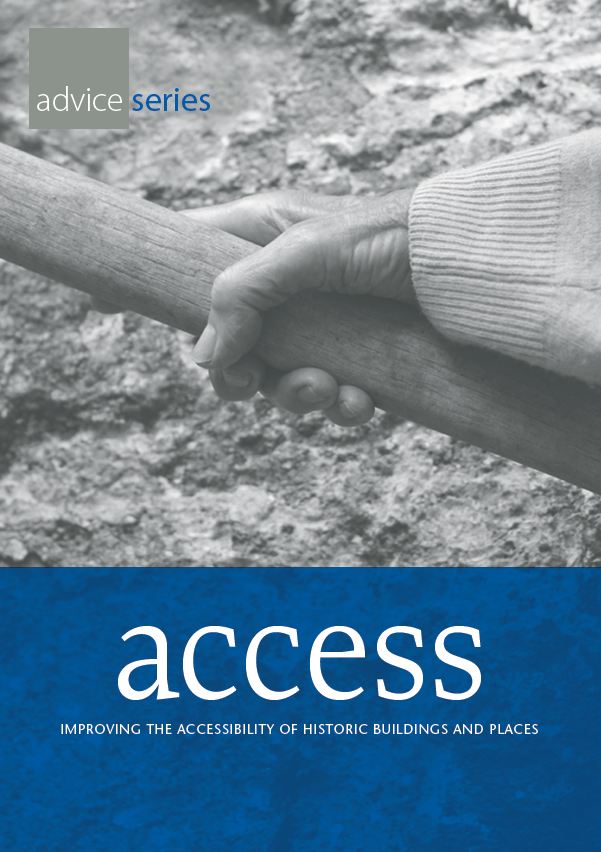Access - Improving the Accessibility of Historic Buildings and Places
Share on social media
The purpose of this guidance is to advise those who own, manage or care for buildings and places of architectural heritage significance on the options available to them to improve accessibility. It also provides guidance and information for anyone with an interest or involvement in issues surrounding the accessibility of historic buildings and places.
 One of the key requirements for an inclusive and sustainable society is that everyone should be able to participate in and enjoy the social, economic and cultural assets of that society. Historic buildings and places are a significant asset, a unique and irreplaceable resource which reflects a rich and diverse expression of past societies and forms an integral part of local, regional and national cultural identity. Historic buildings and places, important in themselves for their intrinsic cultural heritage value, are also significant because of their uses as places where people work, live and enjoy everyday activities.
One of the key requirements for an inclusive and sustainable society is that everyone should be able to participate in and enjoy the social, economic and cultural assets of that society. Historic buildings and places are a significant asset, a unique and irreplaceable resource which reflects a rich and diverse expression of past societies and forms an integral part of local, regional and national cultural identity. Historic buildings and places, important in themselves for their intrinsic cultural heritage value, are also significant because of their uses as places where people work, live and enjoy everyday activities.
Download the PDF document (12 Mbyte) from the website of the National Disability Authority
For some people, barriers exist which make visiting and using historic buildings and places difficult or sometimes impossible.Making the built heritage more accessible in an appropriate and sensitive manner can increase awareness and appreciation of its cultural, social and economic value. It assists in meeting society’s requirement to protect its architectural heritage, whilst also meeting the need to provide equal access for all, as far as is practicable.
The purpose of this guidance is to advise those who own, manage or care for buildings and places of architectural heritage significance on the options available to them to improve accessibility. It also provides guidance and information for anyone with an interest or involvement in issues surrounding the accessibility of historic buildings and places.
It aims to:
- Increase understanding of the principles of architectural conservation and universal design
- Improve awareness and understanding of the relevant legislation and policy
- Provide guidance on preparing an access strategy
- Provide illustrated examples of successful solutions where access to historic buildings and places has been improved
- Assist in determining the practicability of works to improve access to the historic built environment
In making the built heritage more accessible, it is essential to be aware ofpeople’s different needs and how these needs can be met in a variety of ways. It is important to remember that often the best and most appropriate way to make historic places more accessible is through management solutions which may sometimes require little physical intervention or alteration of historic fabric.
Well-planned access strategies,developed at an early stage, can avoid excessive intervention and cost. Where intervention is required, careful, sensitive and elegantly designed solutions should be prepared and carried out by those with the necessary expertise and experience.
Consultation with the relevant stakeholders,including local authority access, planning, building control, fire and architectural conservation officers, may assist in developing appropriatesolutions. In some cases, it may also be appropriate to consult with users with disabilities.
It is important to remember that to successfully improve access to historic buildings and places, it is necessary to address both conservation and accessibility needs in an integrated and balanced manner.
134 pages.
PUBLISHED BY THE STATIONERY OFFICE
To be purchased directly from:
Government Publications Sales Office, Sun Alliance House,. Molesworth Street, Dublin 2
or by mail order from:
Government Publications, Postal Trade Section. Unit 20, Lakeside Retail Park, Claremorris Co. Mayo.
Tel: 01 - 6476834/37 or 1890 213434; Fax: 01 - 6476843 or 094 - 9378964 or through any bookseller.
© Government of Ireland 2011ISBN 978-1-4064-2319-8
All or part of this publication may be reproduced without further permission provided the source is acknowledged. The Department of Arts, Heritage and the Gaeltacht and the authors accept no liability for any loss or damage resulting from reliance on the advice contained in this booklet.
This publication has been produced with the support of the National Disability Authority.
Text by: Shaffrey Associates Architects and Fionnuala Rogerson Architects.
Editorial team: Helena Bergin, Fingal County Council; Feargus McGarvey,Mitchell + Associates; John Wickham, DoECLG and Jacqui Donnelly, DoAHG.
All images are by the authors or DoAHG except where otherwise stated.
Series Editor: Jacqui Donnelly
Design: Bennis Design

